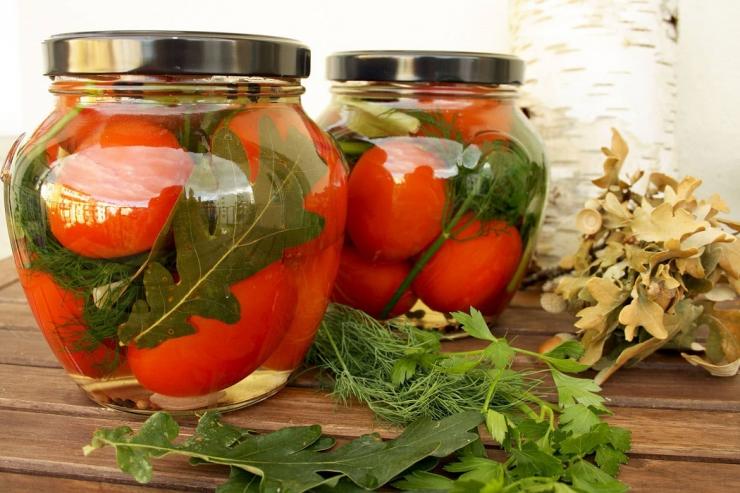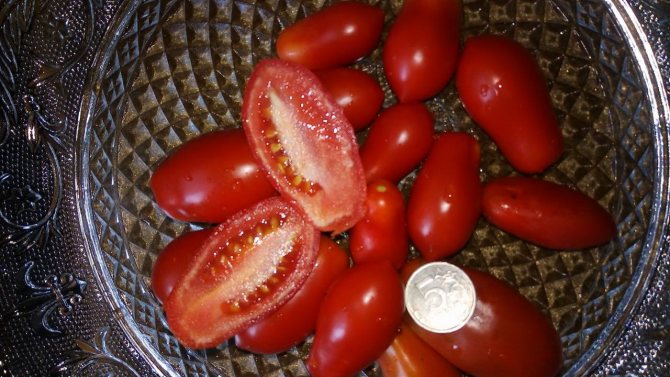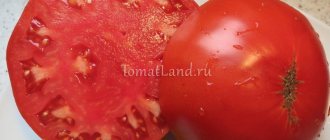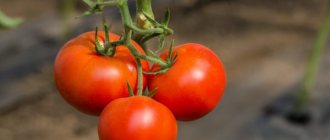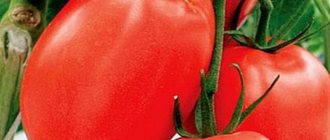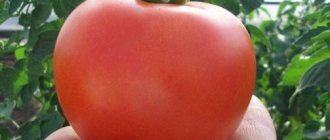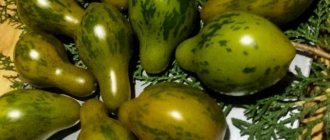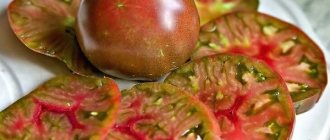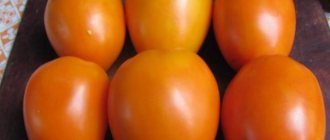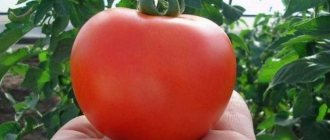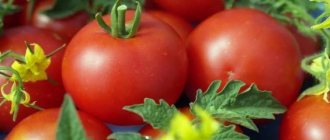Salted delicacy - a variety surprisingly suitable for winter harvesting. Pickled and canned tomatoes are amazingly tasty, have a rich aroma and taste.
| Height | Pick-up location | Ripening terms | Fruit color | Fruit size | Origin | Fruit shape |
| Medium-sized | Greenhouse, Open ground | Mid-season | Red | Middle | Variety | Plum or oval |
Description and characteristics of the variety
Tomato Pickling delicacy - determinant standard medium-sized variety. The height of the bushes does not exceed 1 m, the shoots are straight, the foliage is moderately expressed. On strong bushes, 7-8 fruitful clusters are formed, each with 6-8 tomatoes.
The ripening period is average - 111-122 days from germination.
Description of tomatoes:
- average weight 100-110 g;
- the shape is elongated and rounded, like a plum;
- color solutions from red to pink-raspberry;
- the pulp is fleshy, oily;
- the skin is strong, does not crack.
Country of origin and year of registration
Tomato Pickling delicacy - a find of selection in 2000. Received by breeders from Russia. Included in the register 6 years later.
Growing regions
The variety is intended for:
- middle lane;
- Ural regions;
- Non-Black Earth Region;
- Siberian region.
Feedback
Salted delicacy - a variety that has taken root in my family. I love it for something that requires minimal maintenance: if you put it in the ground, you just water it. Unless you cut off a couple of stepchildren. The stem stands confidently, I don't even tie it up. And my sister respects this species because in her, in the Kuban, she does not need to be pinned: all the tomatoes have time to ripen and already at the end of June lie in even rows in the kitchen, waiting for the first salting. Olga, Chelyabinsk By the way, during the period of growing seedlings, it is extremely important to pay special attention to feeding: once a month it is necessary to use growth stimulants in order to achieve the opposite effect. The greens should not stretch out. Strong, short, stocky shoots in the open field will take root much faster than their tall slender counterparts.
Features of growing and storage
Grown in greenhouses and in open beds, planted traditionally - through seedlings.
Seeds are sown in mid and late March.
A loose fertile substrate is prepared for seedlings, for this they mix:
- leaf turf 2 parts;
- compost 1 part;
- ash 1 cup;
- sand 1 part.
Mineral fertilizers are applied per 10 kg of soil mixture - superphosphate 30 g, potassium sulfate 10-15 g.
Growing features:
- plant seeds to a depth of 1.5 cm;
- before germination, the boxes are covered with foil;
- irrigate with settled water;
- maintain a temperature of 22-24 degrees;
- dive at 2-3 true leaves.
Lighting
Access of light to the penetrating sprouts not only stimulates their speedy germination, but also ensures a high yield of the variety. There are several features here:
- the yield of tomatoes will be higher if a bag of seeds is placed in close proximity to a heat source a couple of months before sowing. So, the central heating battery gives the “warming up” of the future harvest at the level of 25-30 ° С.
- at the time of growing seedlings, the ambient temperature should be from 18 to 23 degrees during the day and from 12 to 15 degrees at night.A window ajar for ventilation mode at night will enable early hardening of seedlings;
- the period of emergence of flowers and the beginning of budding, as a rule, coincides with the planting of shoots in the greenhouse. At this time, the sun naturally heats up the space to 20-25 degrees, at night the temperature drops to 16-18 ° C. It is important to ensure that the thermometer reads 18-20 degrees on the soil during the day, and at least 16 degrees Celsius at night.

Important!
Salted delicacy, like any other tomato, is incompatible with frost. Already when the temperature drops to minus 0.5 ° C, not only the leaves will be damaged, but also the flowers, and therefore the fruits. The plant withers and, even if it partially restores the greens, it will no longer bear fruit.
Tomatoes marinated in halves with onion and garlic
The recipe is also good if you need to save tomatoes from late blight or when the harvest is too large. Medium and large fleshy fruits will be appropriate here. It is convenient to use such a preparation in winter as an independent snack, and for vegetable stews, and for borscht.
Ingredients (for 1 liter can)
- Tomatoes 500 g
- Onions or shallots 1-2 heads
- Garlic 4 cloves
For the marinade:
- Olive oil 1 tbsp l.
- Water 1/2 l
- Salt 0.5 tbsp. l.
- Sugar 1 tbsp. l.
- Table vinegar 9% 2 tbsp. l.
To taste: peppercorns, bay leaf, dill umbrella
How to cook
- I cut the tomatoes in half, cut the onions into rings rather large, approx. 1 cm in thickness, and chop the garlic very finely.
- At the bottom of the jar I put an umbrella of dill, peppercorns, onions and garlic. I pour in the oil. I lay the halves of the tomatoes with the slices down.
- I make a marinade: I pour water into a saucepan, add lavrushka, salt and sugar. As it boils, I pour in the vinegar.
- I pour the marinade into a jar of tomatoes.
- Sterilize for 10 minutes and tighten the lids.
Tips for choosing pickled tomatoes
Important! Pickled tomatoes must contain enough saccharides to allow the natural fermentation process.
During fermentation, lactic acid is formed in the barrel, which acts as a preservative and prevents the tomatoes from becoming moldy. With an insufficient content of saccharides in tomatoes, acid is not formed and the fermented products will become moldy.
You can ferment not only red, but also green tomatoes. In this case, it is better to pick tomatoes of blanche ripeness.
Attention! Salted and naturally fermented tomato is softened by acid.
Therefore, for salting it is necessary to take as hard specimens as possible. Moreover, if for pickling green tomatoes, almost any varieties of tomatoes are suitable, except for salad and sauce, then for pickling ripe tomatoes it is better to select those with a very dense skin. This kind of skin is distinguished by varieties, which are popularly called "plums". All of them have an oblong shape and a rough, thick skin.
Tomatoes with peppers and onions in tomato marinade
Another simple but delicious recipe. This is not just a blank, but a ready-made appetizer for any festive table and for a family dinner.
Ingredients:
- Tomatoes 300g
- Bow 1 head
- Bulgarian pepper 1 pc.
For the marinade:
- Tomato juice 2 cups
- Table vinegar 9% 1 tbsp
- Sugar and salt 1 tablespoon each
To taste: cloves, peppercorns
How to cook
- My tomatoes, pierce each with a toothpick, put them in a jar, pour boiling water over them and leave them for 10 minutes.
- I cut the pepper and onion into large strips and half rings.
- Preparing tomato marinade. Pour tomato juice into a saucepan, put pepper and onion in it, add salt, sugar, pepper and cloves. When it boils, turn off the heat and leave it on the stove for another 5-7 minutes.
- Then I add the vinegar and remove from the stove.
- I drain the water from the jar of tomatoes and pour in the tomato marinade with pepper. I twist the cans.
How tomatoes for processing differ from other varieties
Tomatoes for conservation must meet a number of requirements:
- be medium-sized (it is easy to pass through the neck of the can);
- have a dense skin and pulp, as well as small seeds;
- be characterized by a high content of carbohydrates (sugars);
- be as resistant to pathogenic flora as possible;
- ripen at the same time in large batches or store well.
Experienced gardeners grow tomatoes of these varieties separately, giving them a personal garden bed or part of a greenhouse. This allows you to control the condition of the plants, the ripening of fruits and not be tempted to cut off the target crop for salad.
Landing dates
The time frame for planting the variety does not generally differ from the life span of most tomatoes:
- planting seeds: March 10;
- planting in a greenhouse (greenhouse) - May 10;
- transplanting in open ground - June 10.
Let me remind you that this type of tomato grows in two stems. We step aside to the first brush and tie up the stems so that the fruits do not break the plant.


The first tomatoes are removed from the branch at the end of July (in Siberia and the Urals).
How to grow tomatoes
After 2 months, the seedlings are ready to be transplanted to a permanent place. Tall tomatoes usually outgrow during the seedling period, reaching 40-45 cm in height. This important feature does not allow the bushes to be planted vertically, so they are placed in a half-lying hole.
Landing
Planting scheme: 50 cm - distance between seedlings, 70 cm - distance between rows. For 1 sq. m place 3-4 plants.
The culture is transplanted in the evening or early morning, when the sun does not warm at full strength. Only planted tomatoes do not like direct sunlight, so it will be difficult for them to adapt to new conditions in case of unfavorable factors.
Wells are made in advance with a depth of 20 cm, pre-watered abundantly with warm water. After transplanting, young bushes are watered again with warm water, the earth is compacted and left to get used to constant conditions for at least 8 days.
Care
Regular watering is established as the seedlings adapt. It is watered no more than 2 times a week, but during flowering and fruit formation, the culture requires more moisture. Also, watering is increased during hot and dry days. Watered only with warm, settled water, under the root of the plants, without getting on the leaves.
Attention! Cold water has a detrimental effect on tomatoes. They stop growing and developing.
After watering, the beds are loosened, removing all weeds with roots. Many insect pests breed in weeds, so it is necessary to clean the beds of unnecessary plants. Weeds can be used as mulch; when rotting, it enriches the soil with many useful substances. Also, straw or peat is used for mulch. Mulching retains moisture in the beds longer.
The stem of the bush is so powerful that the culture does not need mandatory feeding. The developed root system is quite capable of nourishing the plants itself with the substances necessary for full development. But experienced gardeners bring in wood ash, which not only feeds the plant, but also protects it from fungal diseases.
Features in care and possible difficulties
The quantitative indicator of fruiting depends on the formation of the bush. To increase yields, experts advise cultivating 2 stems, avoiding thickening of the plantings. To do this, remove all the stepsons, leaving only one shoot under the first flower brush. Patching is carried out periodically, as unnecessary shoots grow.
To restrict growth, it is necessary to pinch the crown, otherwise, without determining the point of growth, the plant will grow up to 2.5 m. Restriction of growth prevents the development of unnecessary branches that will take away the necessary nutrients for its development.
Plants need tying up immediately after transplanting. For this, trellises are installed - this is the best option for solving the problem.As development progresses, fruiting branches are fixed to the support without fail. Many fruits are tied, and the branches cannot support their weight.
Diseases and pests
Strong immunity distinguishes the crop from other salad varieties that are susceptible to many diseases. However, prevention against late blight is necessary, since prolonged fruiting can cause a fungal infection.
Preventive measures include: systematic loosening, moderate watering with control of the humidity level in the beds, removing weeds and ventilating closed structures if the tomato is planted in a greenhouse. Also, before planting, the land is treated with copper sulfate, which destroys fungal spores.
Of the pests for tomato, the most dangerous are aphids and a whitefly butterfly. For aphids, a soap solution is used, which is used to treat the plant stem. The solution is prepared from 1 piece of laundry soap dissolved in 1 bucket of water. If there are a lot of aphids, the whole plant is treated.
Advice. The pungent-smelling herbs planted next to the tomato - calendula, marigolds - protect the culture from many ground and flying pests, including the whitefly. Also, pheromone traps installed next to the bushes are used to fight the parasite.



